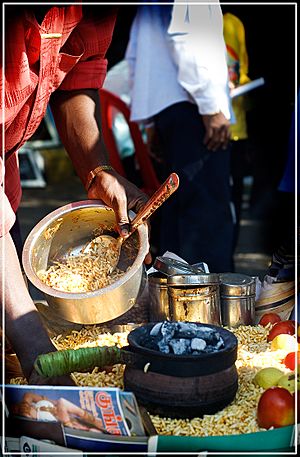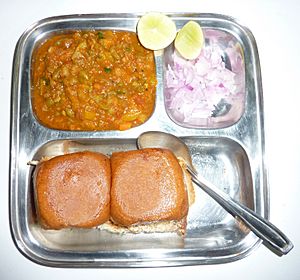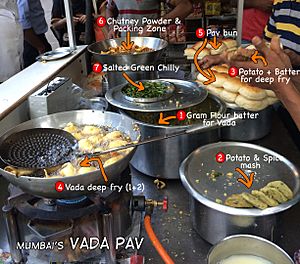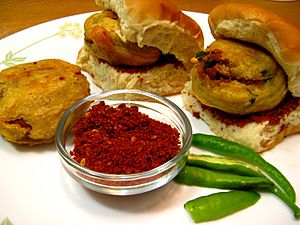Street food of Mumbai facts for kids


Street food in Mumbai is super popular! It's food sold by vendors right on the street from small stalls. This kind of food is a big part of what makes Mumbai special. Even though street food is found all over India, Mumbai's street food is famous because people from all walks of life enjoy it. They eat it almost any time of day! Some even say it tastes better than restaurant food. Many people in Mumbai love to grab a quick snack from a street vendor in the evening. Everyone, no matter their background, loves Mumbai's street food. These vendors have really helped shape the city's amazing food culture. Street food in Mumbai is also usually cheaper than eating at a restaurant. You'll often find these food stalls near busy places like colleges and train stations.
Contents
Mumbai's Amazing Street Food


Mumbai is the biggest city in Maharashtra, so you'll find lots of Maharashtrian food here. The most famous street food in Mumbai is definitely Vada pav. It's a tasty potato fritter served in a bread bun.
What Kinds of Food Can You Find?
You can find many other popular street foods in Mumbai. These include:
- Panipuri (crispy hollow balls filled with spicy water)
- Bhelpuri (a crunchy, tangy snack)
- Sevpuri (flat crispy discs with toppings)
- Dahipuri (similar to panipuri but with yogurt)
- Sandwiches
- Ragda-pattice (potato patties with a pea curry)
- Pav bhaji (a spicy vegetable mash served with buttered bread)
- Chinese bhel (a mix of noodles and vegetables with Chinese flavors)
- Idlis and dosas (South Indian rice dishes)
Most of these are vegetarian. But if you like non-vegetarian food, you can also find omelette-pav, kebabs, and fish on Mumbai's streets. The city has so many different kinds of street food because people from all over India and the world live there. In the 1980s, Indian-style Chinese food became very popular on Mumbai's streets. Other favorites include Misal pav (a spicy curry made from sprouted beans, eaten with a bread roll) and vegetable frankie (a cheaper version of wraps).
Sweet Treats and Drinks
For desserts, you can try Kulfi, which is a frozen dairy dessert like ice cream. There's also golah, which is like a snow cone often served on a stick. Besides snacks, Mumbai has many juice and milkshake stalls. You'll often see vendors selling fresh Sugarcane juice, which is a cheap and refreshing drink. Tea vendors also cycle around the city, selling hot tea. Street vendors usually work all year round, no matter what. You can also find Paan stalls, which sell a special betel leaf preparation eaten after meals to freshen your mouth.
Where to Find Street Food
Some lanes in Mumbai are famous for having lots of street food stalls. These are called Khau Galli, which means 'Food Alley' in the local language, Marathi. Girgaum Chowpatty beach is well-known for its delicious Bhelpuri and kulfi. Street vendors in Nariman Point, a busy business area, do great business during lunchtime.
Mumbai's street food has become so popular that even fancy five star hotels in the city now serve it. Restaurants in other parts of the world have also added Mumbai street food to their menus! In recent years, new fast-food companies have started up, focusing on serving Mumbai's street food. Even with all the different opinions about street food, it's a daily meal for many students and office workers in the city.

